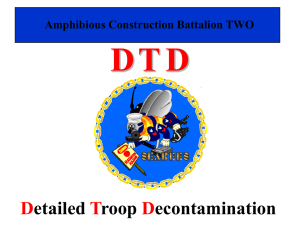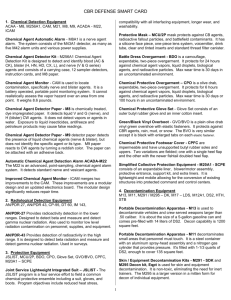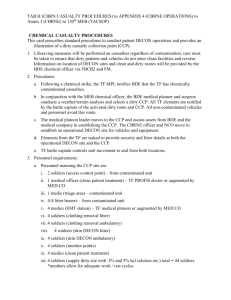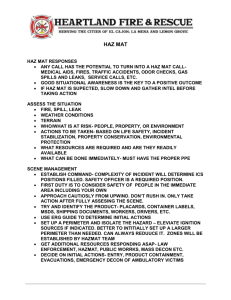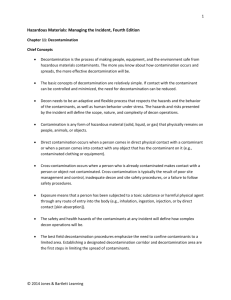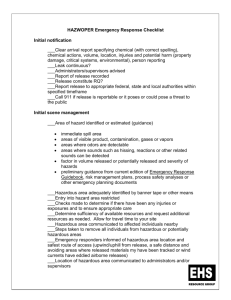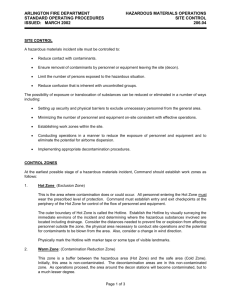Chapter 3 - on ENLISTMENT.US
advertisement
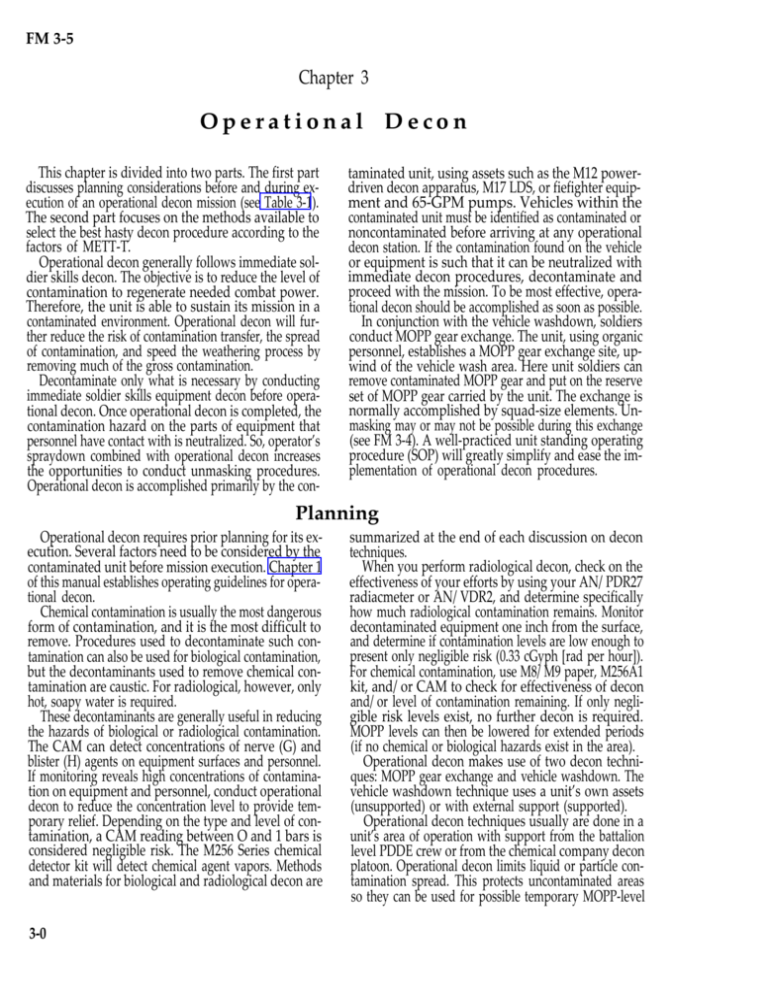
FM 3-5 Chapter 3 Operational Decon This chapter is divided into two parts. The first part discusses planning considerations before and during execution of an operational decon mission (see Table 3-1). The second part focuses on the methods available to select the best hasty decon procedure according to the factors of METT-T. Operational decon generally follows immediate soldier skills decon. The objective is to reduce the level of contamination to regenerate needed combat power. Therefore, the unit is able to sustain its mission in a contaminated environment. Operational decon will further reduce the risk of contamination transfer, the spread of contamination, and speed the weathering process by removing much of the gross contamination. Decontaminate only what is necessary by conducting immediate soldier skills equipment decon before operational decon. Once operational decon is completed, the contamination hazard on the parts of equipment that personnel have contact with is neutralized. So, operator’s spraydown combined with operational decon increases the opportunities to conduct unmasking procedures. Operational decon is accomplished primarily by the con- taminated unit, using assets such as the M12 powerdriven decon apparatus, M17 LDS, or fiefighter equipment and 65-GPM pumps. Vehicles within the contaminated unit must be identified as contaminated or noncontaminated before arriving at any operational decon station. If the contamination found on the vehicle or equipment is such that it can be neutralized with immediate decon procedures, decontaminate and proceed with the mission. To be most effective, operational decon should be accomplished as soon as possible. In conjunction with the vehicle washdown, soldiers conduct MOPP gear exchange. The unit, using organic personnel, establishes a MOPP gear exchange site, upwind of the vehicle wash area. Here unit soldiers can remove contaminated MOPP gear and put on the reserve set of MOPP gear carried by the unit. The exchange is normally accomplished by squad-size elements. Unmasking may or may not be possible during this exchange (see FM 3-4). A well-practiced unit standing operating procedure (SOP) will greatly simplify and ease the implementation of operational decon procedures. Planning Operational decon requires prior planning for its execution. Several factors need to be considered by the contaminated unit before mission execution. Chapter 1 of this manual establishes operating guidelines for operational decon. Chemical contamination is usually the most dangerous form of contamination, and it is the most difficult to remove. Procedures used to decontaminate such contamination can also be used for biological contamination, but the decontaminants used to remove chemical contamination are caustic. For radiological, however, only hot, soapy water is required. These decontaminants are generally useful in reducing the hazards of biological or radiological contamination. The CAM can detect concentrations of nerve (G) and blister (H) agents on equipment surfaces and personnel. If monitoring reveals high concentrations of contamination on equipment and personnel, conduct operational decon to reduce the concentration level to provide temporary relief. Depending on the type and level of contamination, a CAM reading between O and 1 bars is considered negligible risk. The M256 Series chemical detector kit will detect chemical agent vapors. Methods and materials for biological and radiological decon are 3-0 summarized at the end of each discussion on decon techniques. When you perform radiological decon, check on the effectiveness of your efforts by using your AN/PDR27 radiacmeter or AN/VDR2, and determine specifically how much radiological contamination remains. Monitor decontaminated equipment one inch from the surface, and determine if contamination levels are low enough to present only negligible risk (0.33 cGyph [rad per hour]). For chemical contamination, use M8/M9 paper, M256A1 kit, and/or CAM to check for effectiveness of decon and/or level of contamination remaining. If only negligible risk levels exist, no further decon is required. MOPP levels can then be lowered for extended periods (if no chemical or biological hazards exist in the area). Operational decon makes use of two decon techniques: MOPP gear exchange and vehicle washdown. The vehicle washdown technique uses a unit’s own assets (unsupported) or with external support (supported). Operational decon techniques usually are done in a unit’s area of operation with support from the battalion level PDDE crew or from the chemical company decon platoon. Operational decon limits liquid or particle contamination spread. This protects uncontaminated areas so they can be used for possible temporary MOPP-level FM 3-5 reduction. Operational decon supports the need for battlefield mobility; its small operational area (about 100 square meters on site) is easy to conceal in forward areas, and the lower water requirements do away with the absolute need to conduct decon near a water source. Usually, squad-size elements use these two operational decon techniques: vehicle washdown and MOPP gear exchange. Platoons or companies rotate contaminated squad-size elements through the operational decon site one at a time. Responsibilities The Contaminated Unit Squad-size elements and occasionally platoon-size elements conduct operational decon (see Table 3-l). The contaminated unit is responsible for the decon of its soldiers and equipment. The battalion PDDE crew decontaminates equipment with assistance from the contaminated unit. The Battalion Tactical Operations Center The tactical operation center (TOC) coordinates operational decon operations. If the battalion has no decon assets or more assets are required, submit requests to the next higher headquarters for needed support. Decon assets may then be made available from higher or adjacent units. The Battalion PDDE Crew The PDDE crew comes from personnel and equipment within the battalion’s resources. The PDDE is moved, supplied, and operated by the battalion crew. Although the battalion decon crew provides the expertise and does most of the work for the vehicle washdown, they work under the direction of the contaminated unit’s commander or designated representative. Chapter 10 discusses planning factors to determine battalion basic load requirements. Chemical Company Decon Platoon Chemical companies can support the efforts of a battalion PDDE crew by sending one decon platoon or platoon (-) to assist in operational decon. The preferred method is to use supporting decon squads to set up separate operational decon sites rather than use multiple PDDEs at one site. This preserves the advantage of small, decentralized operations. Preparation Phase The preparation stage, as its name implies, includes all of the things that must be done before any operational decon can take place. Request The contaminated unit commander decides to conduct operational decon, and calls the battalion TOC to request support. Coordination The TOC directs the battalion decon crew where to meet the contaminated unit. The contaminated unit chooses the location. Decon sites can be preselected and identified in the operation plan/operation order (OPLAN/OPORD). Linkup points are established in the plan or orders, and are revised based on the situation. 3-1 FM 3-5 Battalion assets may not be available to provide operational decon support. If not, the battalion coordinates with the division (or brigade) for decon support. The contaminated unit generally communicates with the decon crew via liaison personnel for communications, or landline (unit tactical SOP should state which means is used to communicate with decon crew). Site Selection The contaminated unit chooses an operational decon site (a place where little preparation is required) in coordination with its battalion. Generally, the contaminated unit has the most complete knowledge of local conditions and is best qualified to select the decon site. Consider the following factors when selecting a decon site: Good overhead concealment. Good drainage. Off the main route, but with easy access for vehicles. Wind direction. Large enough area to handle vehicle washdown and MOPP gear exchange for a squad-size element (100 square meters per site). A water source. Make maximum use of existing facilities, such as car washes and swimming pools. Plan for about 100 to 150 gallons of water for each vehicle (for example, armored personnel carrier). Of course, larger or dirtier vehicles need more water (see Table 10-3, Chapter 10). NOTE: The M12A1 PDDA can carry 450 gallons to a decon site; the M17 LDS (with collapsible bladder) can hold 1,500 gallons, but must be setup and filled up at the decon site. Rendezvous The contaminated unit meets the battalion decon crew at the decon site. The contaminated unit’s company supply section brings replacement MOPP gear, decontaminants, and skin decon kits to the rendezvous location. This location could be near enemy territory, and the decon crews and company supply section have little, if any, organic security. So, local field SOPs should describe the security and rendezvous procedure for all parties involved to avoid confusion, delay, or confrontation with enemy forces. Site Setup The battalion decon crew will set up a the vehicle washdown area. An operational decon site implies minimal setup and preparation. Site setup requires positioning the PDDE along the roadway, ready to dispense hot, soapy water. The vehicle washdown process basically consists of contaminated vehicles moving forward into a site to be washed down (removing gross contamination) and then moving out. The company supply section provides needed supplies and returns to the company area. Additionally, two soldiers from the contaminated 3-2 unit set up a MOPP gear exchange site. Prepare MOPP gear exchange at a clean site 50 meters upwind of vehicle washdown. The commander may also decide to conduct MOPP gear exchange after the completion of the mission (see FM 3-4). Both the vehicle washdown and MOPP gear exchange operations should operate concurrently. If water for the M12A1 PDDA has been preheated, preparation for vehicle washdown should take no more than ten minutes (this is a guideline). Preparation for vehicle washdown using the M17 LDS will take more time if the water bladder must be filled. (NOTE If METT-T allows, vehicle crew/operators may remove any vegetation used as camouflage from the vehicle and use shovels or similar equipment to remove large amounts of mud. This could be done before the vehicle enters the washdown lane at the hasty decon site). Execution Phase This phase is the actual conduct of the two operational decon techniques: MOPP gear exchange and the vehicle washdown. Site Control and Security Vehicle commanders maintain proper intervals as they move their vehicles through the site. Vehicle operators maintain visual contact with one another to know when to move from concealment to the washdown area. There is only one station in the vehicle washdown technique. The PDDE operator gives a signal when vehicles are required to move into position. All personnel in armored vehicles should stay buttoned up within their vehicles while waiting in the marshaling area. Personnel in wheeled vehicles should dismount before washdown to avoid getting wet. Units will provide their own security as MOPP gear exchange and vehicle washdown is in progress. Processing Each vehicle receives a two- to three-minute vehicle washdown with hot, soapy water from the PDDE. Following this, the vehicle moves to the MOPP gear exchange area, if elected by the unit commander. Soldiers dismount and conduct MOPP gear exchange as a squad or combat vehicle crew. This technique is done by squads or crews so that leaders can control the rate of overgarment exchange, and ensure adequate stocks of overgarments at company level are maintained and accounted. Two soldiers can work as a buddy team, or a soldier can do the technique by himself. However, when squad leaders supervise, they can prevent unnecessary exchanges of MOPP gear by using the CAM (see TC 3-4-l). When finished, soldiers mount their vehicles and move to their new battle positions. For planning purposes, the vehicle washdown site will process one vehicle every 2 to 3 minutes; and MOPP gear exchange will take ap- FM 3-5 proximately 30 minutes. For a squad-size element, estimate 45 to 60 minutes for vehicle washdown and MOPP gear exchange, if both operations are executed concurrently. Using the supported operational decon method, output could increase up to six times the amount of vehicles normally processed. Vehicle Washdown Operational decon sustains the contaminated force by limiting transfer and spread of contamination. This may allow temporary MOPP reduction. The decon option used will depend on METT-T. Soldiers use the PDDE to conduct vehicle washdown. If decon assets are available and the mission permits, it is most effective to conduct vehicle washdown between one to six hours after contamination. This action is in consideration of the physical and psychological degradation of the soldier/crew to perform a mission (see Chapter 1, Equipment Limitations). For further information see FM 3-4. Operational decon should be done as soon as it is practical. The longer you wait to remove or neutralize contamination, the harder it will be to do so. Also, the longer you wait, the more opportunity there will be for agent to spread and make contamination problems worse. Generally, sufficient decon assets may not be immediately available for operational decon because they may be committed elsewhere on the battlefield. Even if vehicle washdown is delayed, conducting operator spraydown and removing gross contamination will speed weathering and limit the transfer and spread of contamination. The options for vehicle washdown technique are: supported and unsupported (See Chapter 1). Operational decon is usually done at forward positions normally near the contaminated squad, platoon, or at a location between alternate fighting positions. The site requires little, if any, preparation. At that location, a battalion-level PDDE crew or platoon (-) from a chemical unit moves forward to decontaminate the vehicles of a contaminated squad or platoon. MOPP Gear Exchange During the MOPP gear exchange, soldiers change their contaminated MOPP gear for new, uncontaminated gear. The squad or platoon is responsible for conducting its own MOPP gear exchange at assembly area of the operational decon site. Decontaminants and chemical suit replacements are provided by the contaminated unit supply vehicle near the decon site or its forward support battalion elements. MOPP gear exchange removes nearly all liquid or solid contamination from soldiers and their individual equipment. When soldiers have little, if any, vapor hazards on themselves, they may use hazard-free areas to temporarily unmask to eat, drink, and rest. Before unmasking and lowering of MOPP levels for temporary relief, conduct unmasking procedures using the CAM or M256-series chemical detector kit (see TC 3-4-1, STP 21-24, or FM 3-4 for unmasking procedures). These techniques do not guarantee conditions to safely allow unmasking on or near equipment. However, soldiers may move upwind of vapor dirty equipment into a clean area or collective protection shelter, check for contamination, and then briefly unmask. Conduct continuous contamination checks and monitoring to ensure you stay in clean areas. Use M256 kit and check every 15 to 20 minutes. Use CAM every 5 minutes. Use the CAM and M256-series kit in conjunction with unmasking procedures. Every type of unit (combat, combat support, and combat service support) must develop its own SOP for obtaining temporary relief from MOPP4, based on its own equipment and missions. Standardize those methods when possible and publish them in unit field standing operating procedures (FSOPs). Even when methods have been standardized, every operation is unique. You must do the following: Recognize and understand contamination hazards and avoid contamination when possible. Protect yourself and your equipment when contaminated. Know the capabilities and limitation of your MOPP gear. Know how to neutralize or remove the contamination hazards. Do only as much decon as you need to continue your mission. For operational and logistical purposes, units should plan to conduct vehicle washdown and MOPP gear exchange concurrently between one to six hours of becoming contaminated. This reduces degradation and improves a unit’s ability to perform its mission. Decontaminants and replacement MOPP gear are provided by a company supply vehicle near the decon site. MOPP gear exchange and vehicle washdown are best employed by squad-sized or platoon-sized elements. When larger elements try to process through a operational decon site, they lose many of the benefits of a small decentralized operation. Benefits of a squad- or platoonsized decon operation include: Tailored decon operations are flexible and responsive to small unit needs. Small, speedy operations are more easily concealed in one location near the forward area. A water source may not be needed at the decon site because most PDDEs have a water-carrying capability to support squad-sized elements. Units may divide into squad-sized elements for operational decon, but additional decon support still may be required. Decon platoons from a chemical company can provide this additional support. They can reinforce the efforts of a battalion PDDE crew. See Figure 3-5. 3-3 FM 3-5 Site Clearance Phase Although the operational decon operation is done rapidly with little site preparation, these areas will be contaminated when the operation is completed. This could be a hazard to friendly forces reoccupying the area. Cleanup METT-T will dictate the cleanup requirements in the vehicle washdown area. The battalion PDDE crew clean up the MOPP gear exchange area. They bury or burn the contaminated refuse and retrieve any unused decontaminants. Burning will cause a downwind vapor hazard. Burying is the preferred method of disposal of contaminated waste. If you burn it, notify the battalion headquarter they should notify any units that may be affected by the vapor hazard. If time and resources permit, boots and gloves can be recycled in accordance with Station 4 of DTD (Chapter 4). Prepare a downwind vapor hazard prediction and notify affected units before burning. The PDDE crew must control contamination runoff during the execution of operational decon. The PDDE crew should move the PDDE a few meters away from the vehicle washdown area and wash the decon equipment, including hoses, after the operation is completed. Wet weather gear or TAP aprons should be decontaminated with STB slurry and retained for future use. If MOPP gear exchange is done at a different location, the contaminated unit will be required to clean up after itself. Marking and Reporting The battalion PDDE crew marks the operational decon site with standard NBC warning markers and reports the contaminated area using the NBC 5 report. Thus, friendly forces can avoid the area. Operational Decon Checklist The following sample checklist (Figure 3-1) can be used by battalion chemical personnel for planning operational decon operations: Methods It is important to remember that performing operator spraydown prior to hasty decon will decrease the conlamination transfer and increase the survivability of the crew. Operational decon can be conducted using unsupported or supported methods. Unsupported operational decon uses the unit’s own resources. Supported opera- 3-4 tional decon uses chemical company assets to support a contaminated unit to speed up the decon process. Unsupported Operational Decon Units use their organic equipment and personnel to operate vehicle washdown. Equipment used should have FM 3-5 water pressure equal to or greater than 60 to 120 pounds per square inch (PSI). This amount of water pressure can remove most gross contamination within the provided time (two to three minutes per vehicle). Before vehicle washdown, contaminated units conduct operator spraydown to increase decon effectiveness. A combination of equipment may be used to conduct operational decon. For example, M12A1 PDDA, M17 LDS, and/or firefighting equipment could be used. Ensure that water pressure will range from 60 to 120 PSI, the pressure rate at which most gross contamination can be removed. The siphon injector nozzle should be used for operational decon– it increases the water pressure, has a larger area coverage, and allows for the use of soap. Depending on the availability of equipment, METT-T, and the tactical situation, units have the option to select one of the following for vehicle washdown: One-lane washdown. Two-lane washdown. One-lane washdown Vehicle washdown is conducted as far forward as possible, and is done by the battalion decon crew (see Table 3-2 and Figure 3-2, on the next two pages). Vehicle washdown is most effective if started within one hour after contamination. Wash each vehicle with hot, soapy water for two to three minutes. Because speed is important and detection is difficult, do not check vehicle for contamination after vehicle washdown. Remove only gross contamination. Two-lane washdown This process is conducted as far forward as possible and is done by the battalion decon crew. Vehicle washdown is most effective if started within one hour after contamination. When using two M17 LDS or other combinations of decon equipment, two-lane operational decon speeds up the process (see Table 3-3 and Figures 3-3 and 3-4). Vehicles are washed with hot, soapy water for two to three minutes. Do not check vehicles for contamination after vehicle washdown. Remove only gross contamination. Set the two washdown points a minimum of 50 meters apart. Each washdown point will be considered a separate lane. A control point may be required to control traffic through both lanes. Supported Operational Decon. For supported operational decon, the decon platoon or platoon (-) will support the mission. As with unsupported operational decon, different types or combinations of equipment may be used to support vehicle washdown. When this method is employed, the chemical platoon leader/platoon sergeant must consider METT-T and the tactical situation. Coordination with the supported unit is required for the placement of separate, dispersed operational decon sites within a small area. A series of options are available to the contaminated unit based on resources available to conduct decon and the current tactical situation. Support can be furnished using two methods: Two-lane washdown. Dispersed operational decon. Two-lane washdown The chemical platoon supports the mission as far forward as possible. Two-lane washdown must use dispersion to avoid a large concentration of troops in one area. Vehicle washdown is most effective if completed within one to six hours after contamination. If washdown is not completed within this time, the unit would do better to perform thorough decon. The vehicles are washed with hot, soapy water for two to three minutes (see Chapter 10, Table 10-3, for estimated water consumption). Do not check vehicles for contamination after vehicle washdown, and remove only gross contamination (see Table 3-4). 3-5 FM 3-5 3-6 FM 3-5 3-7 FM 3-5 3-8 FM 3-5 3-9 FM 3-5 3-10 FM 3-5 3-11 FM 3-5 Dispersed operational decon Dispersed operational decon requires a large area. Three dual lane decon points are dispersed over an area sufficient in size to minimize vulnerability (see Figure 3-5). Any method of operational decon previously described can be used. The resources and unit capabilities to obtain water are critical for this kind of operation. Dispersed operational decon could decon six vehicles every three minutes; however, if the commander also decides to conduct MOPP gear exchange, planning for three assembly areas will be required. One decon platoon is capable of operating three operational decon operations at one time. MOPP Gear Exchange, BDO There are three types of procedures for MOPP gear exchange during operational decon: buddy team, triple buddy system, and individual MOPP gear exchange. Unit commanders decide whether or not to conduct MOPP gear exchange during operational decon. However, the rate of degradation of personnel peaks about six hours after being in full MOPP (see Chapter 1). This factor should be considered before continuing the mission without MOPP gear exchange. Before MOPP gear exchange, soldiers will be checked, using the CAM, to determine who needs to exchange overgarments (see TC 3-12 3-4-1 for use and procedures for CAM). This will prevent an unnecessary use of overgarments stock and speed up the MOPP gear exchange. Buddy Team Method MOPP gear exchange using the buddy team method is best managed with squad-sized elements. Two soldiers can do this technique, but squad leader supervision is recommended. MOPP gear exchange does not begin until replacement overgarments are available. FM 3-5 Individual fighting equipment is decontaminated, and the squad members pick up their replacement overgarments. The squad forms a circle around a lead team. Typically the lead team is comprised of the squad leader and another soldier. The soldiers are paired into buddy teams. The buddy teams are spaced around the circle, with 1 to 3 meters between teams. Control contamination spread by putting contaminated overgarments and discarded decon towelettes in one pile. The soldiers in each buddy team alternate as they go through step 1. At step 2, one team member proceeds through step 8 before alternating. This will ensure there is no spread of contamination onto skin or undergar- ments. See Table 3-5 for detailed instructions on this method. If at any time during the procedure you suspect you have spread contamination onto your skin or undergarments, stop. Decontaminate immediately the suspected area with your skin decon kit. After the area is decontaminated, proceed with the MOPP gear exchange. All contaminated waste is properly disposed of. If possible, place the waste in a hole, spread STB over the waste before covering with earth. Mark the area using the correct warning sign. At a minimum, place the waste in double trash bags. Seal the bags with tape or other material. Mark the area. 3-13 FM 3-5 3-14 FM 3-5 3-15 FM 3-5 3-16 FM 3-5 3-17 FM 3-5 Reverse roles. Repeat steps 2 through 8. This time have your buddy help you through the steps. 3-18 FM 3-5 Triple Buddy Method. This method is used by soldiers equipped with the tankers or aviators mask. A different procedure is required because of the hose attached to the filter canister. A third soldier is needed to hold the filter canister and hose to prevent the transference of contamination to the soldier undergoing procedure. This method reduces the risk of transferring contamination onto skin or undergarments. See Table 3-6 for detailed instructions on this method. 3-19 FM 3-5 3-20 FM 3-5 3-21 FM 3-5 3-22 FM 3-5 Reverse roles. Repeat steps 2 through 8. This time have your buddy help you through the steps. Individual (Emergency) Method It may be necessary for a single soldier to exchange MOPP gear when no one can assist. The contaminated soldier may be alone or his buddy wounded or unable to assist. This method is only used in extreme emergencies since there is a high risk of transferring contamination from the overgarment to skin or undergarments. See Table 3-7 for detailed instructions on this method. 3-23 FM 3-5 3-24 FM 3-5 3-25 FM 3-5 3-26 FM 3-5 3-27 FM 3-5 3-28 FM 3-5 MOPP Gear Exchange (Chemical Protective Undergarment) This method of MOPP gear exchange is performed for units issued the chemical protective undergarment (CPU). The CPU is worn under the combat vehicle crewman uniform system (CVCS) or the battle dress uniform (BDU). There are three types of procedures for MOPP gear exchange when wearing the CPU during operational decon: buddy team, triple buddy team, and individual emergency MOPP gear exchange. Buddy Team Method MOPP gear exchange using the buddy team method is best managed with squad-size elements. Two soldiers can do this exchange, but squad leader supervision is recommended. A lead team composed of the squad leader and another soldier directs the exchange from center of the circle as they go through it themselves. (See Table 3-8). Pair soldiers into buddy (two-man) teams. Space the teams around a circle, with 1 to 3 meters between teams. Control contamination spread by putting contaminated undergarments and discarded towelettes in one pile. If at any time during the technique you suspect you have spread contamination onto your skin or undergarments, stop. Decontaminate immediately with the skin decon kit, then proceed with the MOPP gear exchange. MOPP gear exchange begins when a company supply vehicle unloads replacement undergarments and decontaminants. The squad decontaminates individual fighting equipment at this point and picks up new MOPP gear. The squad members pair up, forming a circle around a lead team. The soldiers in each buddy team alternate as they go through step 1. At step 2, the soldier and buddy no longer alternate between steps. The first soldier goes all the way through steps 2 through 9 before alternating. Now the soldiers reverse roles. This ensures no conlamination is spread onto skin or undergarments. 3-29 FM 3-5 3-30 FM 3-5 3-31 FM 3-5 3-32 FM 3-5 3-33 FM 3-5 3-34 FM 3-5 Triple Buddy Method This method is used by soldiers equipped with the tankers or aviators mask (see Table 3-9). The triple buddy method uses a third soldier for MOPP gear exchange. This soldier holds the cannister and hose, keeping it from transferring liquid contamination to the undergarments. The risk of transfer of contamination is increased because of the contaminated protective mask, hose, and filter. This MOPP gear exchange technique reduces the risk of contamination transfer. Teams consist of three persons. Space the team around a circle, with 2 to 4 meters between teams. The squad members pair up in triple buddy teams, forming a circle around a lead team. The soldiers in each triple buddy team alternate as they go through step 1. At step 2, the soldier and buddies no longer alternate between steps. The first soldier goes all the way through steps 2 through 9 before alternating. Now the three soldiers alternate roles. This ensures no contamination is spread onto skin or undergarments. 3-35 FM 3-5 3-36 FM 3-5 3-37 FM 3-5 3-38 FM 3-5 Individual (Emergency) Method This method of MOPP gear exchange is performed by units issued the chemical protective undergarment. MOPP exchange using the individual (emergency) method is performed only in extreme emergencies and/or life-threatening situations. Using this method increases the risk of transferring contamination to your battledress uniform or your skin. It increases the possibility of casualties. See Table 3-10 for a description of the procedure for individual (emergency) MOPP gear exchange. Do this method only when: You are in a chemical contaminated environment by yourself and MOPP gear exchange is required. Your buddy is wounded or unable to assist in the MOPP gear exchange. The commander authorizes MOPP gear exchange because of the tactical situation. (If the subordinate is cut off from the commander or meets any other conditions that warrant risking this, authorization can be given by the OIC or NCOIC.) If at any time during the technique you suspect you have spread contamination onto your skin or undergarments, stop. Decontaminate immediately with the skin decon kit, then proceed with the MOPP gear exchange. 3-39 FM 3-5 3-40 FM 3-5 3-41 FM 3-5 3-42 FM 3-5 3-43 FM 3-5 3-44 FM 3-5 3-45 FM 3-5 3-46

